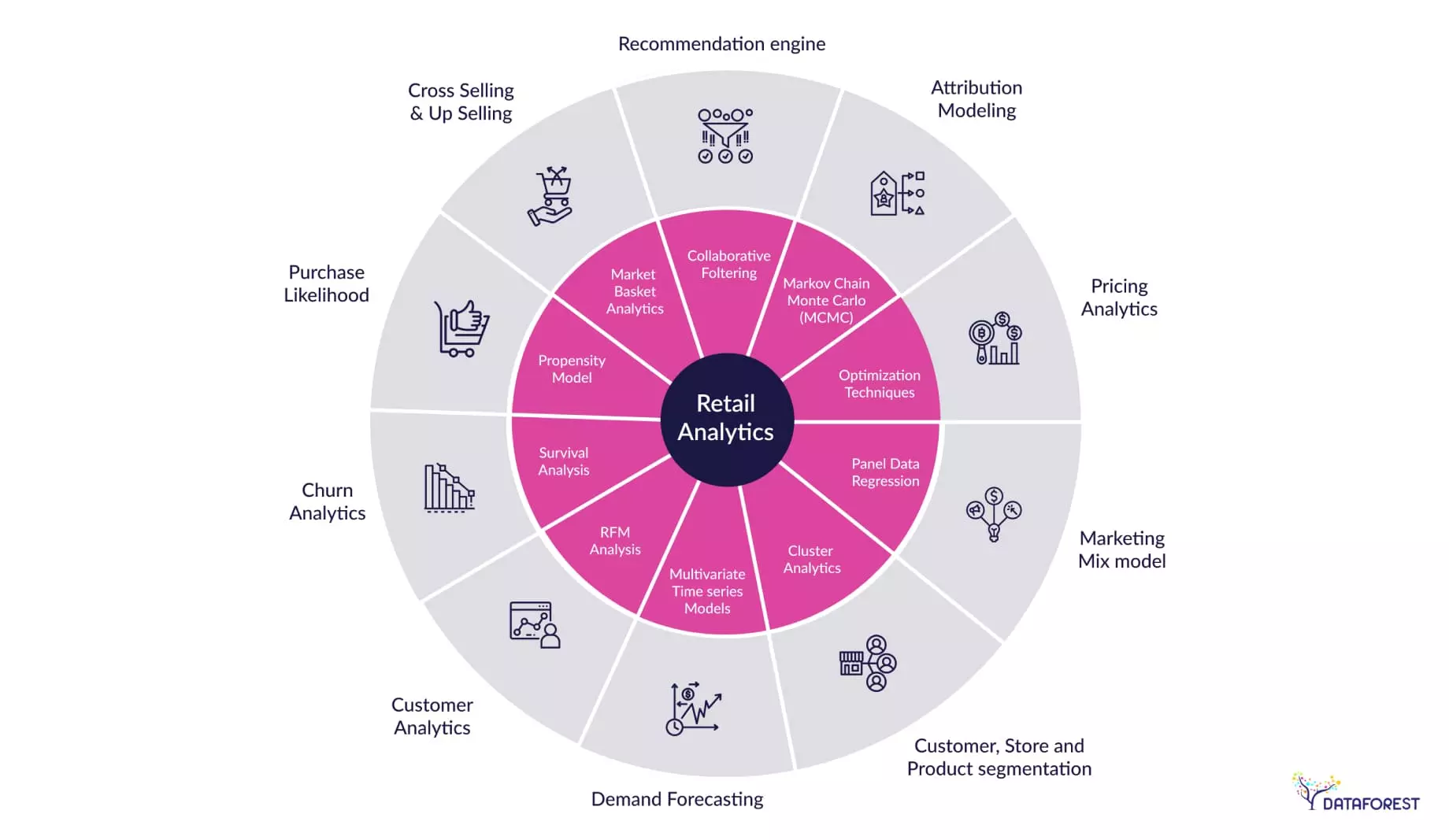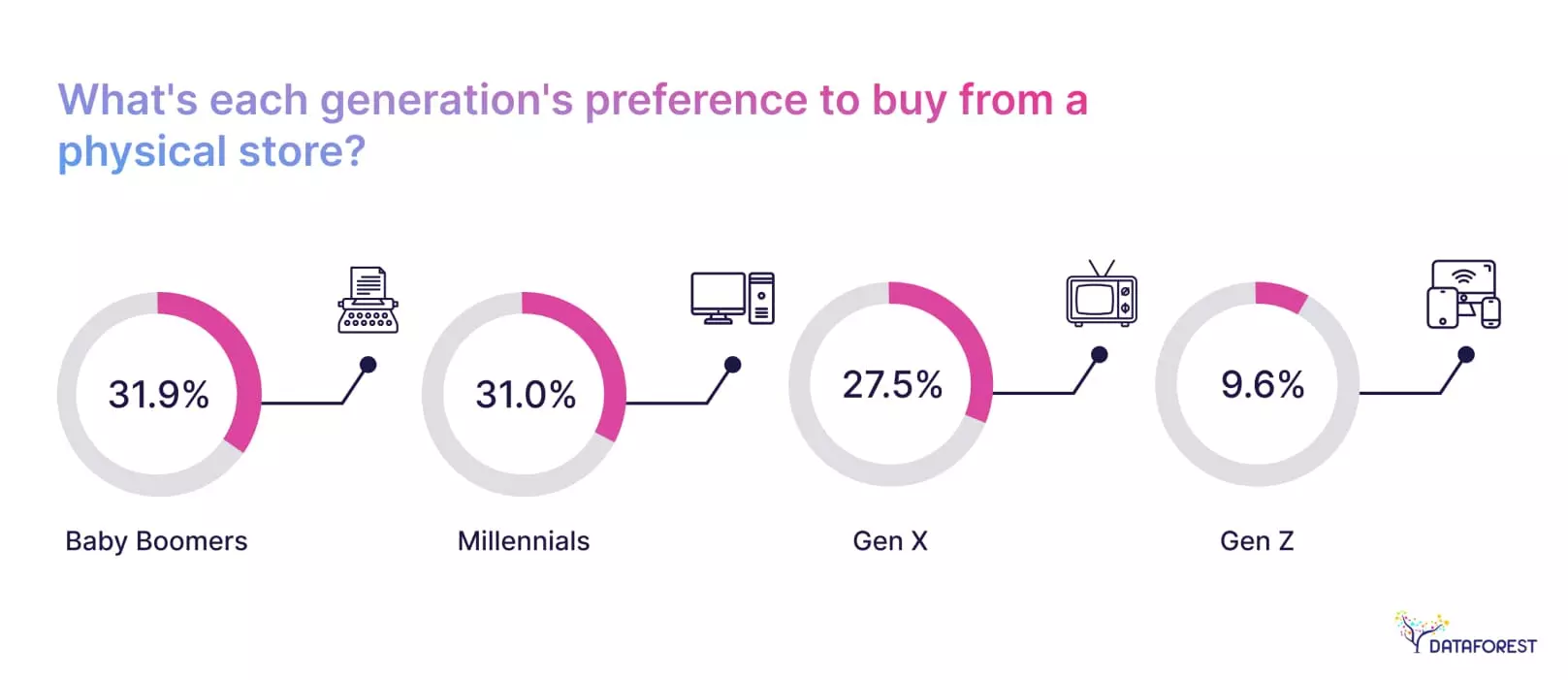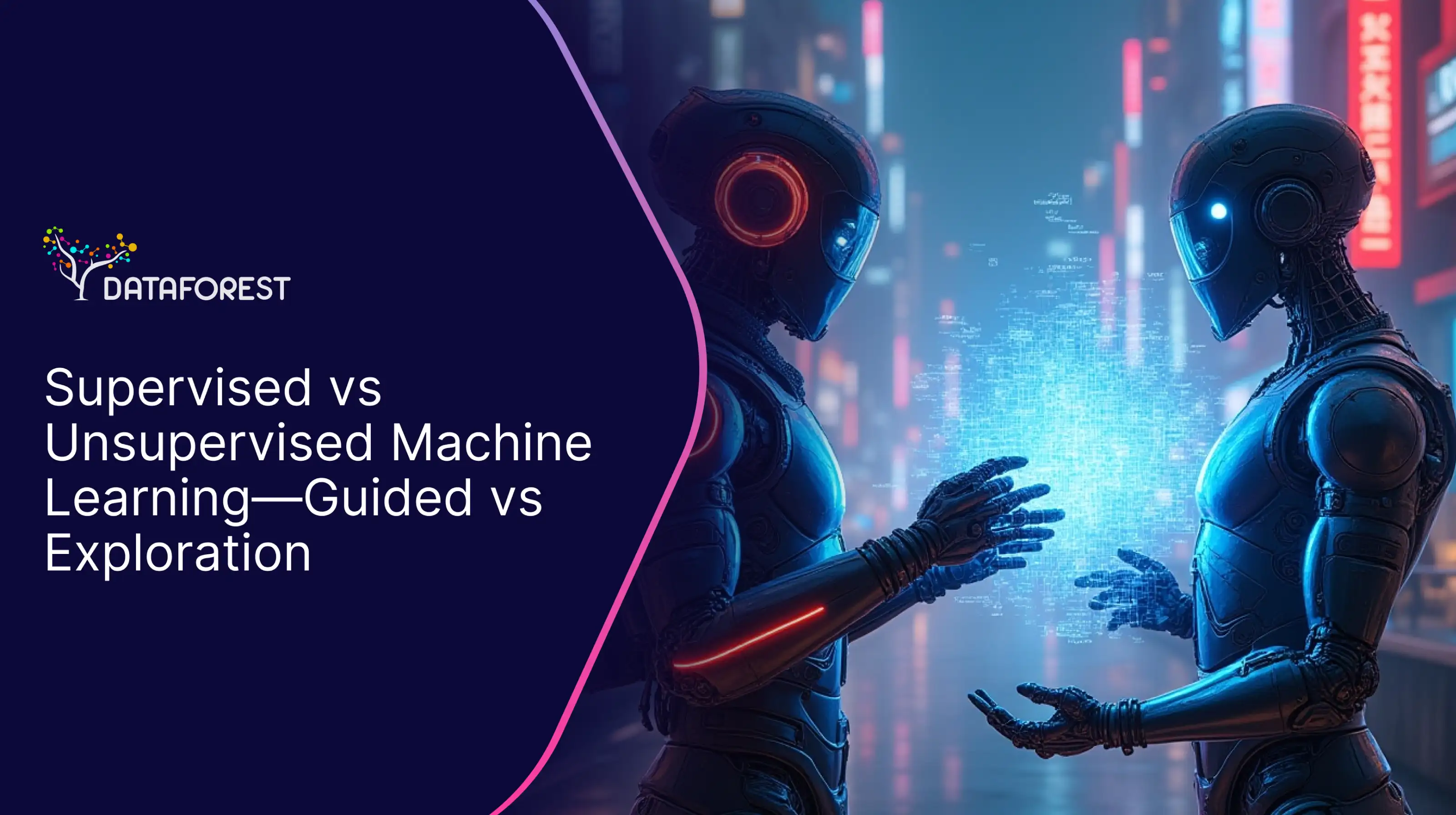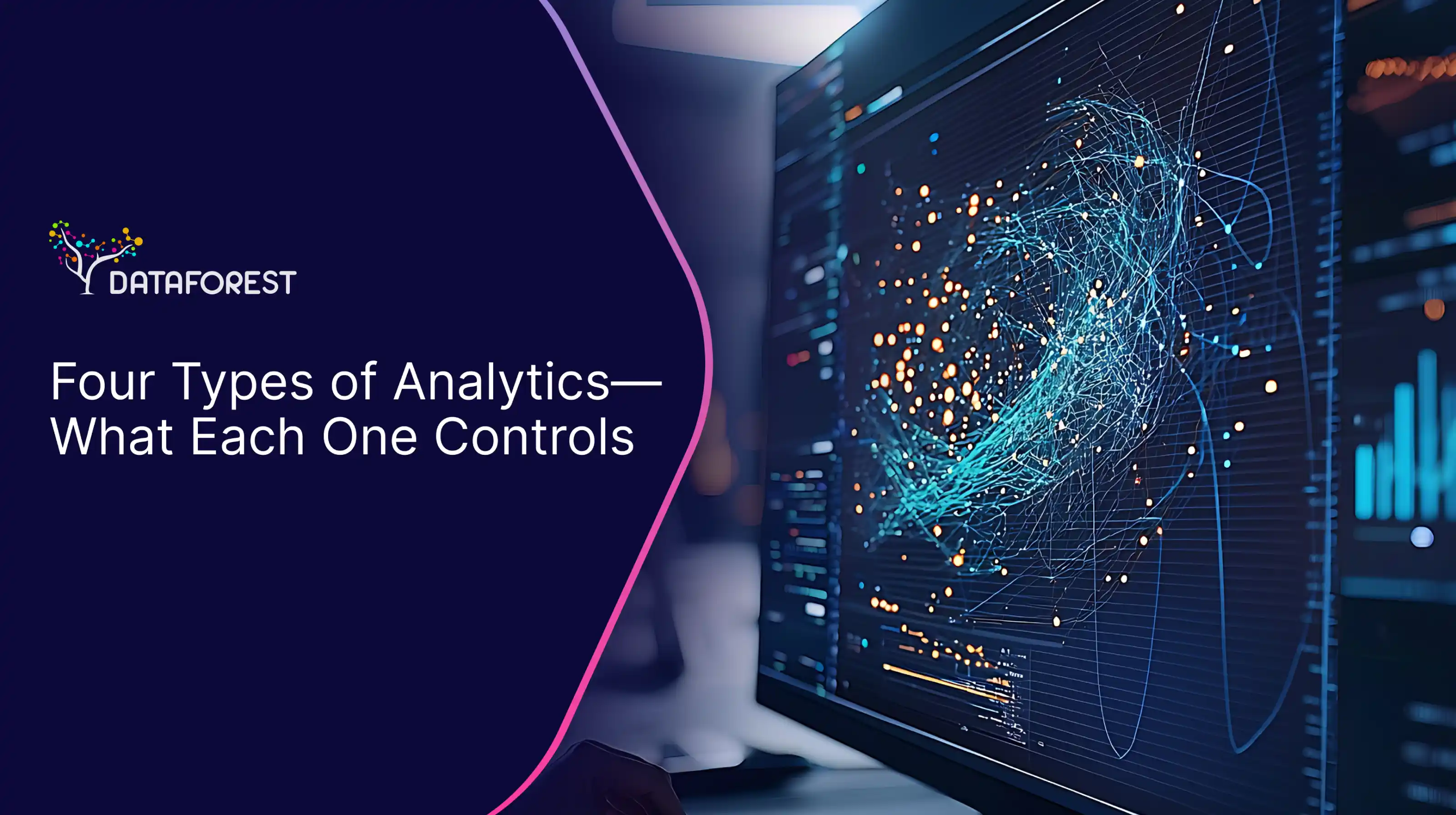One of retail's most luminous data science use cases is personalized customer experiences, where machine learning and big data analytics converge. By analyzing vast datasets, retailers uncover the unique preferences of individual customers, crafting recommendations that resonate on a profoundly personal level. This is about suggesting products and curating experiences that feel tailor-made, as if each customer has a personal shopper understanding of their desires, sometimes before they do. But this is only one facet of this diamond. If you think this is your case, then arrange a call.

Applications of Data Science in the Retail Industry
Customer Segmentation and Personalization in Retail
Data science use cases in retail business include customer segmentation and personalization. This transformation is anchored on analyzing customer preferences with depth and precision previously unimaginable. By applying clustering algorithms such as K-means and hierarchical clustering, retailers segment their retail customer base into groups with shared characteristics or preferences. Predictive analytics and machine learning models, including decision trees and neural networks, further refine this approach by anticipating individual customer's future behaviors based on their past interactions.
Advanced techniques like natural language processing (NLP) dissect customer reviews and feedback, extracting insights into customer trends. This analysis is powered by a suite of tools and platforms that integrate seamlessly with retailers' data ecosystems, including CRM systems and marketing automation platforms, which facilitate the delivery of personalized recommendations and executing targeted promotions with surgical precision, as cases say.
Of all retail data science examples, the one that stands out is Sephora, a beauty retail giant that leverages data science. Sephora's Beauty Insider program collects customer purchase history, product preferences, and shopping behaviors, enabling personalized product recommendations in-store and online. Their "Color IQ" system exemplifies personalization, using technology to scan the skin and recommend the perfect shade of foundation, ensuring each recommendation is as individual as the customer's skin tone.
Demand Forecasting and Inventory Management
Data science use cases in retail businesses utilize advanced artificial intelligence (AI) analytics and machine learning techniques to transform how businesses forecast demand and manage inventory. At the heart of this strategy lies data science methods and techniques to predict product demand and discern emerging market trends. Retailers leverage time series analysis, machine learning models such as ARIMA (AutoRegressive Integrated Moving Average) for forecasting, and clustering algorithms for identifying patterns with buying behavior analytics. These techniques enable a nuanced understanding of how seasonal variations, promotional activities, and economic indicators influence demand.
Retailers deploy advanced tools that integrate predictive analytics to optimize inventory levels and mitigate the risks of stockouts and overstock scenarios. Based on data science cases, optimization algorithms, such as linear programming and genetic algorithms, recommend the most efficient inventory replenishment strategies. These tools consider historical sales data, current inventory levels, lead times, and forecasted demand.
As for retail data science examples, Zara is a global leader in the fast-fashion industry. Zara's agile approach to inventory management optimization is underpinned by its use of data science to monitor real-time sales data and customer feedback across its extensive store network. This data-driven insight allows it to adapt its production and inventory distribution strategies, ensuring that popular items are restocked while minimizing excess inventory for less popular products. Zara's ability to efficiently manage inventory and quickly respond to market demand exemplifies the transformative power of data science in retail.
Dynamic and Competitive Pricing Strategies
Data science retail use cases call for predictive analytics models. This strategy employs many methods and techniques, with machine learning models at the forefront. Algorithms such as regression analysis, ensemble methods, and deep learning interpret vast datasets, identifying patterns that indicate optimal pricing points. These models consider factors including purchase history, time of day, seasonality, and price elasticity to forecast how changes in pricing could influence consumer demand.
Retailers harness potent tools and platforms that integrate these data science models to adjust prices dynamically. Software solutions with AI capabilities analyze real-time data streams from internal sales data, competitor pricing, and market trends, enabling automated price adjustments. This ensures that pricing strategies are responsive to the current market environment and predict future shifts within data science use cases in retail.
If we are talking about retail data science examples, let's look at Uber, a company operating in the rideshare industry. Uber's surge pricing algorithm adjusts fares in real time based on the current demand for rides in a particular area, incentivizing drivers to meet rider demand. While not a traditional retailer, Uber's application of data science to dynamically adjust pricing offers valuable insights into how similar strategies can be employed in the retail sector to maximize sales and enhance customer satisfaction.

What’s each generation’s preference to buy from a physical store?
Fraud Detection and Prevention
Data science use cases in retail offer robust ideas and methods to identify, analyze, and prevent fraudulent transactions. Machine learning algorithms, such as supervised models like logistic regression and random forests, are trained on historical transaction data to discern patterns indicative of fraud. Unsupervised learning methods, like anomaly detection, are employed to spot irregularities in transaction data that deviate from typical customer behavior.
Advanced analytics identify suspicious transactions and safeguard customer data. Network analysis techniques uncover complex fraud schemes by analyzing relationships and patterns between different entities, while natural language processing (NLP) helps monitor and analyze customer communication for potential fraud indicators. Retailers also leverage encryption and tokenization to protect sensitive customer information, minimizing the risk of data breaches.
A prime example of a data science retail use case is seen with PayPal. It employs machine learning models to analyze real-time transactions, assessing variables such as transaction amount, merchant category, and historical account activity. Their models are continuously updated with new data, enhancing effectiveness. This approach enables PayPal to maintain high user security, establishing the data science use cases in retail practice.
Data Science in Retail Sentiment Analysis and Feedback
Data science retail use cases suggest a toolkit for extracting valuable insights from customer reviews, social media, and feedback data. Through sentiment analysis, retailers gauge opinions expressed across customer channels, enabling an understanding of consumer satisfaction.
Natural language processing (NLP) and machine learning algorithms decipher vast amounts of textual data, including text analytics and sentiment classification. These techniques categorize sentiments as positive, negative, or neutral and further analyze the text to identify specific issues mentioned by customers. If you follow the data science cases, advanced AI analytics tools automate monitoring and analyzing customer feedback across various platforms. By identifying customer feedback patterns, retailers mark improvement areas and tailor their products and services to better meet customer needs.
A compelling example of this in action is Domino's Pizza's use of sentiment analysis to transform its brand image. Following a wave of negative feedback, Domino's launched a campaign that addressed customer criticisms, using insights gained from sentiment analysis to improve its recipes and service.
Data Science Use Cases in Retail Supply Chain Optimization
Data science retail use cases in the supply chain involve algorithms and analytics to forecast demand, optimize inventory levels, and streamline logistics operations. Techniques like machine learning models, including time series forecasting and predictive analytics, enable accurate demand forecasting, allowing for just-in-time inventory practices that reduce holding costs and minimize the risk of stockouts or excess inventory. Optimization algorithms such as linear programming and network optimization are employed to design efficient routes for transportation and distribution. For the same purpose, you can book a call to us.
In warehousing, data science tools facilitate inventory management automation, employing Radio frequency identification (RFID) and IoT sensors for real-time tracking of goods. According to data science use cases in retail, these technologies, coupled with machine learning algorithms, optimize warehouse layout and stock placement.
One illustrative retail data science example is seen in H&M's approach to tackling inventory management. Facing over-stock issues and the need for a more responsive supply chain, H&M turned to data science to create a more agile model. They optimized inventory levels across different locations, ensuring that popular items were readily available while reducing surplus stock. Moreover, the company enhanced its logistics operations by using data-driven insights to improve its distribution routes, confirming data science retail use cases experience.
Optimizing Store Layout and Customer Flow
Retail data science examples give businesses insights into designing store environments that cater to consumer preferences. Heat Mapping and customer journey tracking visually represent high-traffic areas and patterns within the store to identify potential bottlenecks and areas of interest. As data science retail use cases suggest, machine learning algorithms analyze data from sales transactions, foot traffic sensors, and customer feedback to recommend product placements and store layouts that maximize visibility. Predictive models further refine these strategies by forecasting changes in customer preferences.
Analyzing customer flow and behavior in physical retail spaces employs IoT devices, RFID tags, and video analytics. These technologies capture real-time data on customer movements and interactions within the store, providing a detailed understanding of how different store layouts and product placements influence shopping behavior. This information is then analyzed using data science models to derive actionable insights, such as the optimal arrangement of aisles.
Data science use cases in retail now represent IKEA. Known for its maze-like store layouts designed to encourage product discovery, IKEA continually uses data science to refine its store design strategy. By analyzing data on customer navigation patterns, dwell times, and purchase history, IKEA identifies areas that are most engaging for customers and those that may require redesign.
Unifying Retail Through Omnichannel Analytics
Data science retail use cases witness its traditionally siloed channels merging into a cohesive omnichannel experience. Integrating data from multiple retail channels requires consolidating diverse data types, from in-store sales transactions to customer service records. Data warehousing and cloud computing facilitate the aggregation of this multifaceted data, while data mining and machine learning algorithms analyze these consolidated datasets to uncover patterns. For instance, customer segmentation models help understand the nuanced preferences of different consumer groups, and predictive analytics can forecast future buying behaviors across channels, per data science retail use cases.
Customer relationship management (CRM) systems, enhanced with AI and machine learning capabilities, track customer interactions across all channels, delivering personalized content and recommendations. Similarly, integrated inventory management systems ensure product availability.
Sephora is a demonstrative data science use case in retail, which harmonizes its online platform with its physical stores to offer a unified shopping experience. Customers use the Sephora mobile app to scan products in-store, read reviews, check inventory, and make purchases. Sephora's "Virtual Artist" tool on its app and website allows customers to try on products virtually, bridging the gap between online and offline experiences. This integration is supported by a robust data analytics framework that captures and analyzes customer interactions across all channels.
Data Science and Predictive Maintenance in Retail
Data science use cases in retail showcase a strategic advantage in this arena, enabling predictive maintenance that ensures retail equipment functions optimally. Applying data science for monitoring and maintaining retail infrastructure involves the collection and analysis of data from sensors, equipment logs, and operational data. Machine learning algorithms—regression models, neural networks, and anomaly detection techniques—are employed to analyze this data, identifying patterns and predicting potential failures before they occur. This allows retailers to schedule maintenance and address issues without disrupting operations.
Predictive analytics platforms integrate with IoT devices to monitor equipment health in real time, providing alerts when potential issues are detected. These platforms utilize dashboard visualizations and automated reporting to keep retail management informed about the status of their infrastructure.
The following stand out from several data science retail use cases. A leading global grocery retailer, Tesco employs advanced data analytics and IoT technologies to monitor its refrigeration units across stores. By analyzing data collected from sensors attached to the units, Tesco predicts equipment malfunctions before they lead to food spoilage. This helps Tesco maintain the quality and safety of its perishable goods and optimizes the energy efficiency of its refrigeration systems.
Data Science in Retail: A Pivot Matrix of Use Cases
Since DATAFOREST has experience in data science use cases in retail, we provide a snapshot of how it is leveraged across various facets of the retail industry to drive efficiency, enhance customer experiences, and improve business performance.
Please fill out the form if you find your case in this table—we have something to offer you.
FAQ
Can data science help retailers optimize their pricing strategies in real time?
As data science use cases in a retail show, it can help retailers optimize their pricing strategies in real time by employing predictive analytics and machine learning algorithms to analyze market conditions, consumer demand, and competitor pricing. These insights enable dynamic pricing adjustments that maximize profitability while remaining competitive.
How is dynamic pricing used in retail, and how does data science play a role?
Dynamic retail pricing adjusts real-time prices based on demand, inventory levels, and competitor pricing. Data science plays a crucial role by using predictive analytics and machine learning algorithms to analyze these variables, enabling retailers to set optimal prices that maximize sales, according to practice taken from data science retail use cases.
What are recommender systems, and how do they improve the shopping experience?
Based on data science use cases in retail, recommender systems are algorithms that analyze user data, such as past purchases and browsing behavior, to suggest products or content that users will likely find interesting or valuable. Cases say they improve the shopping experience by personalizing it, making product discovery more efficient, and aligning suggestions with each user's preferences.
How can data science be used to optimize in-store customer behavior?
Data science optimizes in-store customer behavior by analyzing foot traffic, purchase history, and in-store engagement through machine learning and analytics, identifying patterns and preferences. This insight enables retailers to tailor store layouts, enhance the shopping experience, and increase sales due to data science use cases in retail.
How does data science enable retailers to create personalized marketing campaigns?
Data science enables retailers to create personalized marketing campaigns by leveraging machine learning algorithms to analyze customer data, such as purchase history, browsing behavior, and preferences, as we see from data science retail use cases. This analysis helps craft targeted messages and offers that resonate with individual customers, increasing engagement and driving sales.
Can data science predict customer preferences for new product launches?
Data science can predict customer preferences for new product launches using predictive analytics and machine learning to analyze trends, past consumer behavior, and market data. As data science retail use cases show, retailers can tailor their new products and marketing strategies to meet their target audience's anticipated preferences and demands.




.svg)





%20(1).webp)















